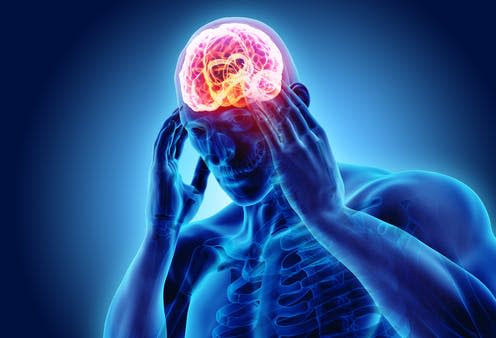Cluster headache is more than 'just a headache' – but this excruciating condition is often misdiagnosed

Cluster headache is more than just a headache. It is a severe neurological condition, sometimes known as a “suicide headache” because many patients have suicidal thoughts during attacks. The pain experienced during a cluster headache attack is excruciating and is said to be comparable to the pain of childbirth. Such attacks can last from 15 minutes to three hours and can occur several times per day. The pain is almost always on one side and typical features of an attack may include bloodshot or teary eyes, droopy eyes and a runny nose or blocked nostrils.
Around one in 1,000 people experience cluster headache. It’s perceived as a rare disease, but in fact is as common as well-known neurological conditions such as multiple sclerosis or Parkinson’s disease. Getting the right treatment for this condition is difficult, as our recent study showed.
We found that many healthcare professionals do not know cluster headache or how to diagnose the condition. This has serious consequences for those suffering. Our research also shows patients regularly face long delays and undergo unnecessary procedures and referrals to specialist care before receiving the correct diagnosis and treatment.
Our team examined the understandings and experiences of cluster headache and the impact of the condition. GPs and neurologists who work in the north of England, were interviewed by a medical sociologist. We explored their knowledge around the diagnosis and treatment of cluster headache, how they usually refer patients to a specialist, and the ways they communicate with other clinicians.
Our main finding is that cluster headache is neglected among health professionals. Many healthcare professionals do not know what a cluster headache is. This frequently leads to misdiagnosis of the condition and huge delays in receiving the correct diagnosis. Some clinicians interviewed in the study were not aware of cluster headache, while others thought that cluster headache is the same as “cluster migraine”, which can cause nausea and sensitivity to light alongside severe head pain.
Our interviewees gave plenty of examples of the consequences a patient faces when they don’t receive a timely and correct diagnosis. Cluster headache is often misdiagnosed as migraine or trigeminal neuralgia (a severe, sudden form of face pain), but also as sinusitis or dental problems. Patients occasionally undergo unnecessary procedures, such as teeth extraction, sinus washouts and intracranial surgery because they are in despair.

The condition has a huge impact on sufferers’ everyday life and they try all kinds of treatments hoping to find some relief from the excruciatingly painful attacks. Indeed, cluster headache can have significant influence on a patient’s mental health and on their ability to remain in employment. People with cluster headache often suffer from severe mental health conditions, such as chronic depression, suicidal thoughts and may self-harm. Family, friends and employers often don’t grasp the severity of the condition and the enormous impact it has.
Challenges with treatment
Due to the nature of the attacks, cluster headache is treated differently compared to other headache conditions, like migraine or a tension-type headache. These are normally treated with painkillers – but if these occur frequently they will require regular preventive treatment. Cluster headache attacks are treated with nasal sprays or injectable medication (triptans) and inhalation of oxygen.
Our study also highlights tensions between primary and secondary care around prescribing these treatments because of the cost. Sometimes GPs don’t follow the treatment instructions received from neurologists in secondary care. This is especially the case if GPs think the suggested medication is not cost effective.
For example, the injectable triptans were often not prescribed because of their high cost. Some GPs instead prescribed cheaper oral triptans. But these are not effective for cluster headache patients. Many interviewed clinicians were not aware of the prescription policies for oxygen, which is an effect treatment for cluster headache.
GP participants in our study rarely referred patients with cluster headache symptoms to neurologists. When patients get referred, it is more likely to provide the patient with reassurance that their condition is not life-threatening. In some cases, patients with cluster headache get referred to neurologists to begin specialised treatments for cluster headache, such as the drugs verapamil and lithium.
Our study shows an urgent need to increase awareness of cluster headache among health professionals and the general public. This will prevent misdiagnosis and delays in diagnosis.
This article is republished from The Conversation under a Creative Commons license. Read the original article.

Professor Lisa Dikomitis received funding from the Headache Research Trial Fund at the Hull University Teaching Hospitals NHS Trust to carry out the CHIPS study.
Fayyaz Ahmed has served on the advisory board of Allergan, ENeura, Electrocore, Novartis, TEVA and Eli Lilly for which the honorarium received has been paid to charitable organisations i.e., British Association for the Study of Headache, Migraine Trust and Anglo-Dutch Migraine Association and has received funding from the Headache Research Trial Fund at the Hull University Teaching Hospitals NHS Trust to carry out the CHIPS study.
Alina Buture does not work for, consult, own shares in or receive funding from any company or organisation that would benefit from this article, and has disclosed no relevant affiliations beyond their academic appointment.

